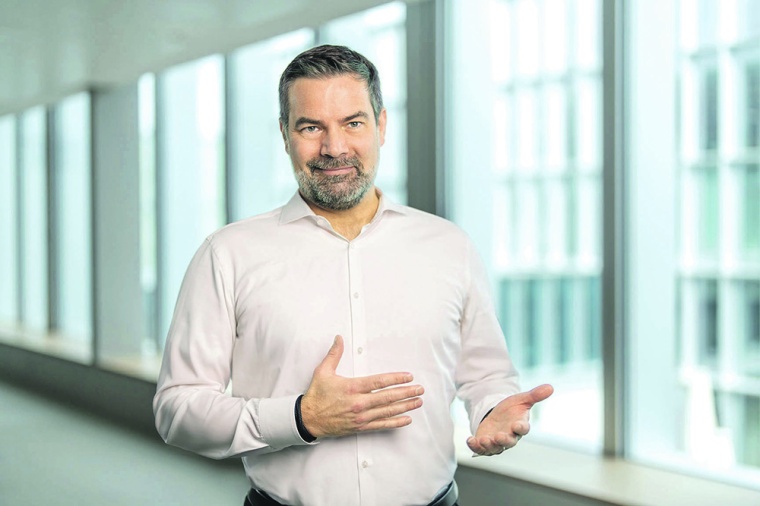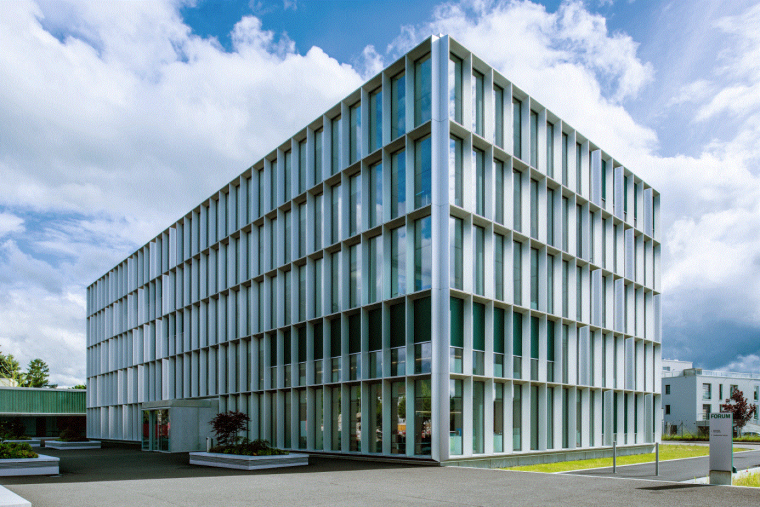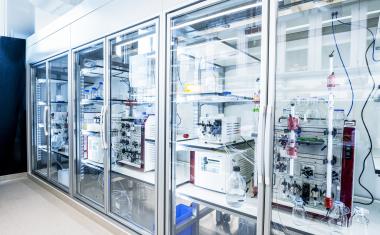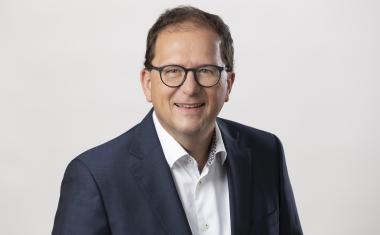"We Want to Be a Big Fish"
The CDMO (contract development and manufacturing organizations) business has a bright future, of that Siegfried CEO Wolfgang Wienand is certain. The economic advantages alone speak for this compared to in-house production by the pharmaceutical companies themselves. Although Siegfried has already reached sufficient critical size within its industry, he sees the company continuing on its growth path. The goal is to take over an even larger share of the value chain from pharmaceutical companies in the future.
CHEManager: In your view, what characterizes a good CDMO?
Wolfgang Wienand: It's the combination of various success factors. There is technology, capacity, regional footprint, cost competitiveness, to mention a few. However, the most important one is trust. That is important in any business of course, but it is especially true between a pharmaceutical company and a CDMO. Firstly, of course, because the products we manufacture ultimately end up in the bodies of patients. So, the expectations in terms of quality and reliability are particularly high, for good reason.
But there is also a commercial point. A certain product, manufactured by us, may generate sales in the tens of millions for us, but such a product can very well represent sales in the billions for the customer. This means that if we can't deliver, it's not good for us, but it's even worse for our customers, because they may lose hundreds of millions or billions as a result.
Since our customers can hardly reflect this risk contractually, for a pharma company it eventually boils down to the simple question: Do I trust this company? Do I trust these people, for them to stand up and make it work and deliver what they promised? Underpinning this trust with tangible actions and consistent performance is crucial if you want to be a strategic partner and successfully operate in the high-value segments of the CDMO market.
How do you establish this trust?
W. Wienand: Among other things, by a proven track record and by having critical size. This ensures that you have a high degree of stability on the financial side and don't fall over at the first gust of wind. It is also advantageous to have a global presence so that we can supply and support customers in all relevant markets. Since we have several locations, we are able to offer dual sourcing within the Siegfried network, i.e., the manufacture of a product at two or more different locations. This gives us redundancy in the network and flexibility on the capacity side.
What other factors play a role?
W. Wienand: Trust is of fundamental importance, but of course, it is not enough if you want to play in the most attractive CDMO segments. That's why there is a whole group of other important factors. These include technological breadth, i.e., the ability to offer customers a solution to their problems, whatever they might be. As a CDMO, you have to be able to handle the full range of chemical technologies. Otherwise, the customer ends up with a scattered supply chain in which one CDMO performs only one or two steps before the next one has to take over.
How important are the aspects of quality and cost?
W. Wienand: Price is not everything in our market. But of course, the customer wants to be supplied at competitive prices. While this is a relative measure, quality, in turn, is absolute. You have to be able to prove over decades that you really know how to manufacture safe high-quality APIs (active pharmaceutical ingredients) or drugs. The challenge, which only the few leading CDMO master, is to check the box for all of them and not only a few and fail on the others. Then and only then you qualify as a trusted strategic partner to the pharmaceutical industry to industrialize their most precious innovations.
You are one of the few suppliers who offer the manufacturing of active ingredients and finished dosage forms of drugs under one roof. What benefit does this offer to your customers?
W. Wienand: The synergies between these two segments in terms of equipment, technologies and qualification of personnel are limited. However, the integration of these activities in the hands of one supplier offers a compelling value proposition for our customers. Taking over such a large chunk of our customers' value chain leads to a maximum reduction in complexity on the customer side. This includes not only the manufacturing of APIs and Finished Dosage Forms (FDFs) for our customers, but also the management of the supply chain and a uniform quality management system. A large pharmaceutical company often has thousands of suppliers. This causes enormous complexity, as all these suppliers must be managed and kept on track. As an integrated supplier we provide everything from a C2 or C3 building block over the complex active ingredient to almost any finished dosage form from a single source and within consistent management of quality, processes and supply chain.
Is the combination of drug substances and drug products the CDMO model for the future?
W. Wienand: That is our conviction. Basically, with our integrated setting we are anticipating the future supply model in our industry as we expect it to evolve. We believe that in five to ten years, large CDMO companies like Siegfried will have taken over an even larger part of the pharmaceutical value creation for our customers comprising both, the development and manufacture of the active pharmaceutical ingredient and the finished dosage form of a drug. We want to and will be able to support our customers in the solution of as many of their tasks as possible.
The challenges for CDMOs are great: intense competition, cost pressure, constant technological advancements, and consolidation – how do you respond to this demanding environment?
W. Wienand: We have set our sights on playing in the top segment of the CDMO market. This is where we see the greatest opportunity to differentiate ourselves and earn adequate returns. That was and is our strategic goal. We have achieved this step by step over the past decade through organic growth and acquisitions and are now number five or six in our market.

“We have set our sights on playing in the top segment of the CDMO market.“
Why is it so important to play at the top?
W. Wienand: Pharmaceutical customers give their most important innovations and products, i.e., their most precious assets, to the strongest and most capable CDMO. To be strong and to be able to offer the broadest range of capabilities, a CDMO needs critical size in terms of capacities and breadth of technologies. In return, they expect efficient problem solving, highest quality and security of supply, but are also prepared to pay accordingly, because only then the CDMO have the necessary to invest in the necessary critical size.
How do you define critical size – is it depth of service, is it geographic distribution, is it measured by revenue?
W. Wienand: The critical size is derived as an imperative from the aforementioned success factors: Quality, financial stability, flexibility, capacity, technology breadth. Each individual criterion is always associated with size. So, how broad is our technology portfolio? It is only broad if we can afford to invest in a broad set of high-end technologies. To be able to afford a lot, we need a lot of sales with adequate profits.
On the capacity side, if I want to offer dual sourcing for security of supply, flexibility and capacity that is available also on short notice, we also need size. As a small CDMO with 200 cubic meters of capacity, I can't afford to have 50 cubic meters or 25 percent of my total capacity sitting around idle because a customer might request additional volumes on short notice. But if I have a total of 2000 cubic meters, then 50 cubic meters represents only 2.5 percent. I can afford that. That gives us spare capacity to help a customer if needed. A pharmaceutical company expects that from its strategic partner.
So, on the one hand you have achieved critical size, but on the other hand you also say that you still want to continue to grow. What role will Siegfried play in the consolidation of the CDMO industry in the coming years?
W. Wienand: We want to stay in the top ten. And to advance further. We want to be big fish and consolidate, not small fish and be consolidated. That's our ambition, that's what our strategy is geared towards. To achieve this, we have the necessary will, ideas, know-how and the necessary financial resources.
How much money can you raise for this?
W. Wienand: Without having to increase capital, about half a billion Swiss francs.
You have a strong presence in the small molecule sector, and you repeatedly emphasize how important this is for you. Will you use acquisitions to diversify and put more emphasis on biologics, for example?
W. Wienand: In the area of M&A as well as organic investments, we are proceeding in three directions. First, it is part of our strategy to further strengthen ourselves where we are already strong, be it organically or through acquisitions. Secondly, we are pursuing the approach of adding certain technologies to our portfolio. I am thinking here, for example, of particle technologies like micronization, lyophilization or spray drying. The same applies to drug delivery platforms in the area of formulation. The third field of action concerns entering CDMO market segments where we are not yet active. It is quite conceivable for us to enter the space of biological drug substances like proteins or antibodies. We would most likely not build this up organically but do this through an acquisition. In addition, there is cell & gene therapy, which is at the forefront of medicinal research. We can also imagine an investment there because we believe that this segment can be very attractive for Siegfried.
“If you want to grow, you need a growth mindset in your teams and a positive attitude towards change.”

Siegfried is now 150 years old. According to your ideas, the company should continue to be active in the next 150 years. What will it take to achieve this?
W. Wienand: We need to retain and further develop our strong corporate culture. This is characterized, among other things, by a will to grow and, at the same time, to take good and sustainable entrepreneurial decisions which hold true not only tomorrow but far beyond. If you want to grow, you need a growth mindset in your teams and a positive attitude towards change.
Furthermore, of course, we need sustainable economic success. Because this puts us in a position to earn the financial resources we need to invest in our future and to capture the many opportunities in this growing market.
Are you confident that the large pharmaceutical industry will continue to need the services of CDMOs in the future? Or do you think it's possible that the trend could go back to more in-house production at Big Pharma?
W. Wienand: I consider the basic logic of the CDMO model to be very conclusive and compelling. It is driven by the fact that pharmaceutical companies want to invest their cash in innovation and new therapies. They don't want to invest it in brick and mortar. So as long as they can find a reliable, capable, high-quality partner and the manufacturing process can be sufficiently well described, specified and controlled, there is a strong incentive for them not to invest in their own capacities but outsource. Incidentally, this is also what their investors expect.
In addition, from the point of view of diversification, we as a large CDMO can do something that even Big Pharma cannot: When pharma companies keep their own production facilities, they can essentially use them for their own drugs only. This means that even for large companies their in-house manufacturing portfolio is limited. This translates into a significant risk of underutilization or even write-offs of their expensive assets if an important product fails and the volumes disappear.
We as a large CDMO, on the other hand, can go to any pharmaceutical company in the world and thus can create a much larger portfolio of projects and products. These are of course inherently risky, too, but the individual risks are much better diversified in our larger portfolio leading to a much lower risk of underutilization and idle costs. In the end, this leads to greater capital efficiency at the CDMO as compared to in-house manufacturing by a pharmaceutical company. These economic benefits for our customers are tangible and real. And that's why I am so confident that the CDMO business model with its sound economic logic will continue to thrive.
Author: Thorsten Schüller, CHEManager

















